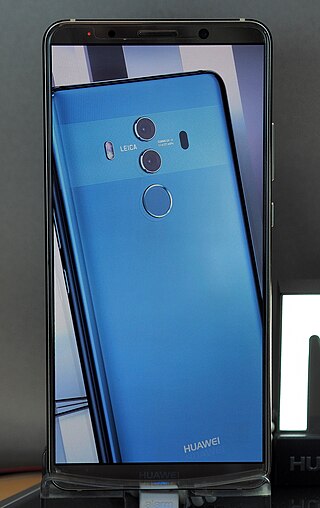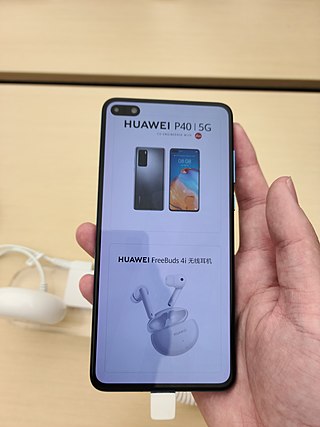
Asus PadFone is a smartphone manufactured by Asus and released in April 2012. The phone is marketed with companion tablet dock and keyboard dock accessories intended to improve functionality and battery life. It fits into a 10-inch tablet dock. It is not the same as the Asus PadFone mini 4.3, revealed by Asus in December 2013 since that operates on Android 4.3 Jelly Bean and is skinned with the Asus' ZenUI.

A phablet is a mobile device combining or straddling the size formats of smartphones and tablets. The word is a blend word of phone and tablet. The term is largely unused by the late 2010s, since average PDA sizes eventually morphed into small tablet sizes, up to 6.9 inches (180 mm), with wider aspect ratios.

The Huawei Watch and latest Huawei Watch 4 series are HarmonyOS-based smartwatches developed by Huawei. The Huawei Watch is the first smartwatch produced by Huawei. It was announced at the 2015 Mobile World Congress and released at IFA Berlin on September 2nd. The Huawei Watch 3 was introduced in June 2021 after the United States Department of Commerce added Huawei to its Entity List in May 2019.

The Huawei Mate 10, Huawei Mate 10 Pro and Huawei Mate 10 Lite are Android smartphones designed and marketed by Huawei as part of the Huawei Mate series. There is also a Mate 10 Porsche design, which has 256 GB of storage but is otherwise identical to the Mate 10 Pro. They were first released on 16 October 2017. Versus the predecessor Mate 9, the Mate 10 pro flagship phone has a faster processor with an integrated neural processing unit, a slightly larger OLED screen (6.0") with a taller 18:9 aspect ratio, a significantly longer battery life and a glass back construction. Chinese and international models are available in dual SIM configuration. It comes with Android 8 and a newer version of Huawei's EMUI interface. All Mate 10 models are unlocked and GSM only. Huawei phones, including the Mate series, are not sold or financed through U.S. carriers due to pressure from U.S. intelligence agencies, though they are available from independent and online retailers.

EMUI, It is an interface based on Android developed by Chinese technology company Huawei. Used on the company's smartphones primarily globally.

Huawei P20 and Huawei P20 Pro are Android smartphones manufactured by Huawei. Unveiled 27 March 2018, they succeed the Huawei P10 in the company's P series line.
Android Go products were first showcased at MWC 2018 with six products: Nokia 1, ZTE Tempo Go, Alcatel 1X, General Mobile GM8 Go, Lava Z50, and Micromax Bharat Go. The Blu Vivo Go became the first Android Go device with Android Pie Go edition.

The Huawei Pura series is a line of high-end and medium-range HarmonyOS smartphones produced by Huawei. The P series was formerly marketed as part of Huawei's larger Ascend brand, and some models were called P smart.

Huawei Mate 20 is a line of Android phablets produced by Huawei, which collectively succeed the Mate 10 as part of the Huawei Mate series. The flagship models, the Mate 20 and Mate 20 Pro, were unveiled on 20 July 2018 at a press conference in London.

A foldable smartphone is a smartphone with a folding form factor. It is reminiscent of the clamshell design of many earlier feature phones. Some variants of the concept use multiple touchscreen panels on a hinge, while other designs utilise a flexible display. Concepts of such devices date back as early as Nokia's "Morph" concept in 2008, and a concept presented by Samsung Electronics in 2013, while the first commercially available folding smartphones with OLED displays began to emerge in November 2018.

Huawei P30 is a line of Android-based smartphones manufactured by Huawei. Unveiled on 26 March 2019, they succeed the Huawei P20 in the company's P series line.
HarmonyOS (HMOS) is a distributed operating system developed by Huawei for smartphones, tablets, smart TVs, smart watches, personal computers and other smart devices. It has a multikernel design with dual frameworks: the operating system selects suitable kernels from the abstraction layer in the case of devices that use diverse resources.

The Honor 8x is a smartphone made by Huawei under their Honor sub-brand. It is a successor of the Huawei Honor 7x within the Huawei Honor series.

Huawei P40 is a line of high-end Android-based smartphones manufactured by Huawei. Unveiled on 26 March 2020, they succeed the Huawei P30 in the company's P series line.

Celia is an artificially intelligent virtual assistant developed by Huawei for their latest HarmonyOS and Android-based EMUI smartphones that lack Google Services and a Google Assistant. The assistant can perform day-to-day tasks, which include making a phone call, setting a reminder and checking the weather. It was unveiled on 7 April 2020 and got publicly released on 27 April 2020 via an OTA update solely to selected devices that can update their software to EMUI 10.1.
The Huawei MatePad Pro is an Android-based tablet designed and marketed by Huawei as part of their Huawei Mate series. It was announced on November 25, 2019 and was released on December 12, 2019.

Huawei Mate 40, Huawei Mate 40 Pro, Huawei Mate 40 Pro Plus and Huawei Mate 40 RS Porsche Design is a high-end Android and HarmonyOS based phablets developed by Huawei for its Mate series, succeeding the Huawei Mate 30 range. They were released on October 22, 2020 at Huawei's Online Global Launch Event.

The Huawei P50 and P50 Pro are HarmonyOS-based high-end smartphones manufactured by Huawei. Unveiled on 21 July 2021, they succeed the Huawei P40 in the P series. In March 2023 Huawei released their successor Huawei P60 Series phones in China, and in May 2023 it released the Huawei P60 Pro in Europe.
The version history of the HarmonyOS distributed operating system began with the public release of the HarmonyOS 1.0 for Honor Vision smart TVs on August 9, 2019. The first expanded commercial version of the Embedded, IoT AI, Edge computing based operating system, HarmonyOS 2.0, was released on June 2, 2021, for phones, tablets, smartwatches, smart speakers, routers, and internet of things. Beforehand, DevEco Studio, the HarmonyOS app development IDE, was released in September 2020 together with the HarmonyOS 2.0 Beta. HarmonyOS is developed by Huawei. New major releases are announced at the Huawei Developers Conference (HDC) in the fourth quarter of each year together with the first public beta version of the operating system's next major version. The next major stable version is then released in the third to fourth quarter of the following year.














